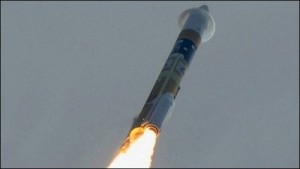Akatsuki: Dawn rises again at Venus

Akatsuki – Though by now its main antenna is probably brown or black from being baked by the sun – Powered by a NEC uPD55117B-018 16-bit processor.
Akatsuki, Japanese for Dawn, was launched in May of 2010 for a journey to the morning star, Venus, on a JAXA H-IIA rocket. The H-IIA flight computer runs on a space rated version of the NEC V70 32-bit processor, running the NEC RX616 RTOS. A processor significantly faster than that of the interplanetary probe it was launching.
“it will have a short cruise to Venus, entering its long, elliptical orbit in December. Its mission should last several years. “
In space, things don’t always go as planned…
On December 7th Akatsuki entered orbit around Venus, December of 2015 rather than 2010. Due to a valve in the fuel pressurization system not opening all the way the orbital insertion engine ran much too lean on its attempt to enter orbit, causing it to overheat and catastrophically fail. This left the probe on a heliocentric orbit, moving away from Venus. The Japanese Space Administration (JAXA) was not deterred, Akatsuki’s orbit would eventually meet up with Venus again, almost exactly 5 years later. JAXA determined they could use the probes attitude control thrusters, which feed off the same fuel tank as the failed main thruster, to insert Akatsuki into a highly elliptical, yet still useful orbit. Had the Attitude control system used a separate fuel system (which is actually the more common design method) this would not have been possible, as it would take a relatively large amount of fuel, fuel that was available on Akatsuki due to the main engine failing and being shut down before its burn was completed. It should be noted that such a maneuver had never previously been even proposed, let alone attempted. There was however another small problem…
The design life of Akatsuki was 4.5 years, 7 months to get to Venus, and 3-4 years of science work. It also was not designed for the thermal stresses of how close it was going to be to the Sun on its way back to Venus. However, JAXA, and NEC, who built the probe, were confident that it would survive. For one, the batteries (one of the very first probes to use Li-Ion batteries) would not need to be used in that time. The High Gain Antenna was also novel flat design, a design chosen to limit heat build-up, a rather fortuitous choice. Some of the instruments may suffer damage (currently they are being tested, and at least the cameras are in good working order), but JAXA was confident the probe could last.
Akatsuki’s electronics kept on working throughout. Akatsuki uses the same Data Handling Unit (DHU, the ‘main’ computer on the probe) as the Hayabusa Asteroid mission. It is powered by an NEC uPD55117B-018** 16-bit microcontroller. This MCU is a rad-hard design with floating point support, MMU, DMA controller, and bus controller all implemented on a single rad-hard ASIC. Data memory is provided by 1,020MB of SDRAM, backed by 2GB of Flash Memory. Akatsuki runs on the uITRON RTOS (likely the RX116 NEC variant) which is responsible for keeping the probes systems in order, and executing all commands sent from mission control. Each of the science experiments/cameras most likely have their own processors as well, as is typical of an interplanetary probe. All this runs on solar panels that provide 500-700Watts, backed by a pair of 23.5A/Hour Li-Ion batteries. The Li-Ion batteries become very important in selecting the orbit Akatsuki can be in. Any orbit places the probe in eclipse for a period of time, which means for a period of time the solar panels cannot generate electricity and the probe has to rely on the batteries to keep running, and keep the electronics the right temperature. For Akatsuki that limit is 90 minutes, a very small chunk of the current 14 day orbital period.
After over 5 years, well past its design life, Akatsuki made it to Venus, requiring a 20 minute burn of its thrusters, and has already returned science data. In a testament to the tenacity and hard work of JAXA engineers, they expect to have several years of science work at Venus, pushing the probes life far further than anyone guessed. We look forward to the science that Akatsuki will provide, it is capable of learning things about Earth’s sister planet that no other probe has been able to.
**Information on exactly the processor used is scarce. This document from NEC states the uPD55117B-018 is used by the DHU in Hayabusa, which is the same design as Akatsuki. This is a standard space-spec processor used by NEC, but there is little information about it. If it does in fact run the RX116 RTOS (as mentioned here) then it is most likely a derivative of the NEC V50, which is of the V20/V30 line, an upgrade of an Intel 8086 processor.



